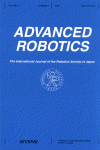
Natural resolution of ill-posedness of inverse kinematics for redundant robots: a challenge to Bernstein's degrees-of-freedom problem
A robot designed to mimic a human becomes kinematically redundant, i.e.its total degrees of freedom becomes larger than the number of physical variables required for description of a given task. Kinematic redundancy may contribute to enhancement of dexterity and versatility, but incurs
a problem of ill-posedness of inverse kinematics from the task-description space to the robot joint space. Such ill-posedness of inverse kinematics was originally found by A.N. Bernstein as the 'degrees-of-freedom problem' in physiology, who also pointed out the importance of unveiling the
secret of the central nervous system in how nicely it coordinates a skeletomotor system with so many degrees of freedom interacting in complex ways. However, in the history of robotics research, such ill-posedness of inverse kinematics has not yet been tackled directly, but circumvented by
introducing an artificial performance index and determining uniquely an inverse kinematics solution by minimizing it. This paper aims at challenging one of Bernstein's problems and proposes a new method for resolving such an ill-posedness problem in a natural way and in a dynamic sense without
invoking any artificial performance index. Instead, a novel concept named 'stability on a manifold' is introduced and it is shown that there exists a sensory feedback signal from the task space to the joint space such that it enables the overall closed-loop dynamics to converge naturally and
coordinately to a lower-dimensional manifold describing a set of joint states fulfilling a given motion task. This result is also extended by using the concept of 'transferability to a submanifold' in the case of short- or middle-range movement such as a task of multi-joint reaching.
Keywords: BERNSTEIN'S PROBLEM; INVERSE KINEMATICS; MULTI-JOINT REACHING; REDUNDANCY RESOLUTION; REDUNDANT ROBOTS
Document Type: Research Article
Publication date: 01 April 2005
- Access Key
- Free content
- Partial Free content
- New content
- Open access content
- Partial Open access content
- Subscribed content
- Partial Subscribed content
- Free trial content